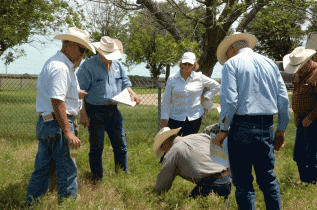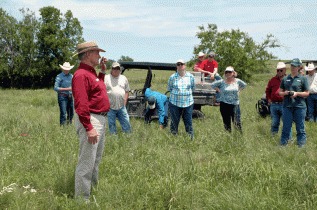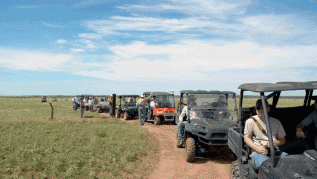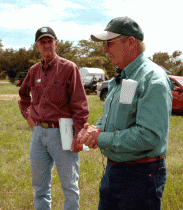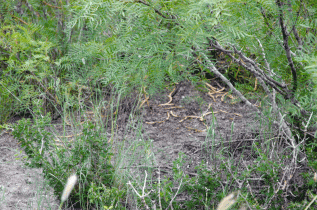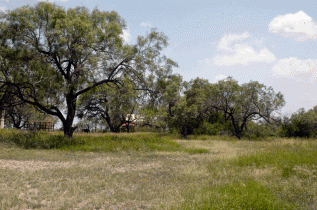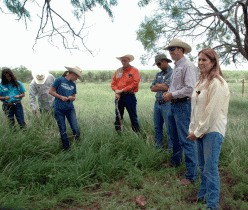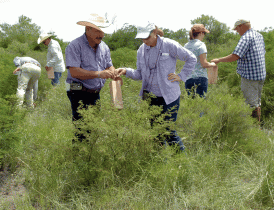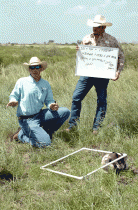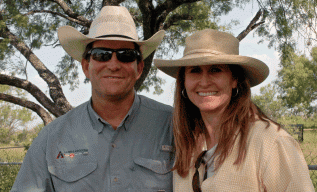We just completed two Cows & Quail workshops in Texas where ranchers and land stewards learned how Holistic Grazing Planning helps livestock and wildlife thrive together. Peggy Cole, HMI Project Manager, has put together this report on days activities and the impact the program made on the participants.
North Texas Cows & Quail Workshop
The feel was festive as old timers and new comers to ranching gathered at the Holman Center in Henrietta, TX for the North Texas Cows & Quail Workshop. Many commented they were here partly to be with other holistic managers they have met over the years through workshops like this one. Sponsors Tx Range Minerals, GLCI, Quail Forever and Capital Farm Credit, along with host HMI, Birdwell and Clark Ranch and the 54 participants helped fund the event.
Deborah Clark told the story of the Birdwell and Clark Ranch and how the values, vision and goals have shaped every decision. Deborah Clark and Emry Birdwell ranch to make a living, so cows come first and to that end the land must be healthy and able to produce forage. Birdwell and Clark and their 9 pointers love to hunt quail, so that quality of life aspect is also part of their goal. Blending those two passions is something Birdwell and Clark do very well and it is what we have come here to see.
Dr. Richard Teague presented a convincing argument for planned grazing with research findings to back it up. You can read more on that research at https://www.sciencedaily.com/releases/2011/06/110615161800.htm
Dr. Kelly Reyna Kelly has begun a quail corridor to keep populations from declining because of such small isolated communities of coveys. Lots of folks showed interest in being a part of this. You can read about it at https://biology.unt.edu/unt-quail/nt-quail-corridor along with quail research and other UNT Quail information.
Finally Guy Glosson, manager of Mesquite Grove Ranch near Snyder, TX showed some slides of how they are recovering from devastating fires in a drought condition. Guy argues for diversity in plants and animals as the basis for resilience and multi-species habitat.
After pizza and a grilled chicken salad, we drove the 7 miles out to the ranch, loaded onto about 10 ATV’s and drove out into the pastures for a look. Kelly Reyna presented a bit different habitat picture for quail than Dale Rollins does in the rolling plains or at the west Texas Cows & Quail last summer. While Dale emphasized the birds can’t run through thick grasses and need frequent brushy cover, Kelly says there is a lot of latitude in the needs of quail, so do what is good for the cows if that is your goal. Though the prairie ecoregion pastures on the Birdwell and Clark Ranch were pretty lush and even, with plant spacing close together, we heard quail calling at every stop and flushed them frequently as we drove through the pastures.
Emry Birdwell described how he makes decisions on how big to make the paddock and how long to leave the cattle there. Richard Teague talked in the field about reading the land and what it might be telling you. He has watched this land improve under the management of Birdwell and Clark for the past 5 years. His respect is evident. Guy Glosson’s observations stimulated discussions on dealing with trailing, on the role of litter and other messages from the ecosystem processes.
We looked at areas stressed by proximity to major watering locations and talked about possible solutions, including the portable water trough that has eased pressure near the lakes by moving watering activity farther afield.
We looked at different soil types and the effect of soil on plant communities. Richard Teague demonstrated a phone app that can tell you on which type of soil your phone is hovering and even which plants you are likely to find there. The app is part of NRCS’s Web Soil Survey (https://websoilsurvey.nrcs.usda.gov/app/HomePage.htm). We looked at stressed plumb thickets - effect of cows or drought? We looked at riparian areas and the reasons NRCS offers payments to defer grazing there to better the chances for healthy, clean water downstream.
Back at headquarters, the gathering shifted gears to relaxing, networking and meeting new friends as Emry fired up the long grill and sliced a custom steak for each participant, who then grilled it to his own idea of perfection. The conversations lingered into the night.
Back in the classroom next morning, Guy Glosson talked about why a goal is needed for making management decisions. He conducted a short exercise on looking at the life you want to lead before considering how to get there with your current resource base. He talked about some of the considerations that go into making management decisions about improving land health and biodiversity using cattle as a tool.
Then it was back to the ATV’s and watching the men become boys as they raced around the ranch, stopping to look at conversation pieces such as dung beetles and exclusion areas on the way to watching the cattle move. Watching a herd of 3800 yearlings moving to fresh pasture is quite an experience - for both the humans and the cattle. Lots of excited energy for both species, but in the end, we had to go off and look at grass before the most curious among the cattle would stop watching us and move on into the new pasture.
We then examined where they had been - the water trough that moves with the cattle, the mineral train, the trampled dirt and the grazed pasture that still looked green and leafy.
Back to headquarters where the Henrietta Chamber of Commerce had prepared hamburgers and salad. The day was cloudy and breezy so not too hot but the rest in the shade of the big trees was welcome before the field exercises of the afternoon.
Richard Teague introduced Kirk Gadzia’s simplified method of biological monitoring https://rmsgadzia.com/PDFs/Bulleseye.pdf The forms are in the appendix of that document. We divided into 6 teams to complete a bullseye on poor ground and another on good ground walking distance from headquarters.
After all groups had completed the assignment, we gathered in a large group and each smaller group reported its answers and why. Dr. Teague said he is interested in what methods will actually produce monitoring records, asking if it was advantageous to work in groups with discussion and different opinions. Most agreed it was. He proposed combining monitoring and social gatherings, so that the same group of friends gather at Ranch X for monitoring followed by the bar-b and beer, then next month at Ranch Y and so on. Most agreed it would take the drudgery out of monitoring, though you might need the same group of friends each time to keep the data collection consistent.
Guy Glosson conducted a field exercise in calculating Animal Days per Acre. With one person as a corner “post”, 3 other folks walk out to form a square. They keep moving out until the forage in the square looks like it would feed one 1,000 pound cow for one day. Strides are counted on each side of the square to determine the square yards of the area to be later used in calculations for areas of similar quality.
Dr. Reyna had a field exercise prepared for wildlife habitat evaluation, but assessed the group as hot and full of information so the day was adjourned at 4:15. Evaluations showed the workshop to be excellent and recommended by all, with a special thanks to Emry Birdwell and Deborah Clark for sharing their knowledge, their home and their steaks so graciously.
South Texas Cows & Quail Workshop
On June 20 & 21, 2013, 30 participants met at the Holiday Inn in Jourdanton, TX to see what they could learn about the relationship between livestock and wildlife. Three teachers collectively representing more than 85 years of experience in the field represented HMI in this 2-day workshop. In the classroom and in the field, Dr. C. Wayne Hanselka, Steve Nelle and Jason Hohlt presented on the needs of the land, the animals and the people managing the whole. Steve Nelle began with an exploration of what it means to be a land steward. The ethics and values of those who care about the land constantly guide actions and decisions in the management of that land. Stewardship includes caretaking, conservation and husbandry, along with deep and careful thinking. Nelle recommended 2 books by Aldo Leopold:
and
as required reading for land stewards. Leopold said, “A land ethic reflects the existence of an ecological conscience, and this in turn reflects a conviction of individual responsibility for the health of land.” and, “An ethic, ecologically, is a limitation of freedom of action”
Nelle took these ideas into his discussion of the ecological processes; stating “those who do not understand nature are destined to deplete it, while those who understand nature best are compelled to conserve it.” Learning to read your land is key. Know the plants and animals nature puts there as well as the ones you put there. Nelle’s fundamental ecological concepts include: Diversity, sustainability, habitability, carrying capacity, limiting factors, and side-effects that might occur with any action. Diversity, a wide variety of plants and animals, creates stability and resiliency in a landscape. Sustainability includes ecological, economic and social stability and resiliency.
Dr. Hanselka followed logically with a discussion of planning to assure progress toward a holistic goal that includes values and ethics, production possibilities and a future resource base that is able to sustain production far into the future. Holism is about the interdependence of ecological communities. Holistic Management is all about understanding that interdependence and using it in planning and decision-making to assure sustainability (ecological, economic and social stability and resiliency) and monitoring to stay on course.
Hanselka talked about many of the key principles in Holistic Management and possible levels of planning, including a strategic plan (a set of decisions about what, why and how to do something, all with a focus on the future), a tactical plan (implementing toward the strategic plan) and operational plan (the day-to-day actions of the team members). Any plan requires an intended destination—the holistic goal—and guiding all decisions to progress toward that goal. And those decisions are based on an understanding of the ecological processes of water cycle, nutrient turnover, energy capture and transformation, and vegetation dynamics.
Ranchers are in the solar energy business with each acre of land representing 43,500 square feet of solar panel, transforming solar energy into nutrient energy that can be transformed into meat and eventually into dollars for the rancher. Water capture and use depends on vegetative cover on the soils to catch and hold raindrops for use in growing the solar panels (vegetation). Nutrients are carried into the soils by insects and a variety of other ecological processes such as decay. Vegetation dynamics is the natural succession of plants up and down the scale of diversity, complexity and efficiency in their work as solar panels.
Jason Hohlt kicked off the next portion with the habitat needs of cattle, followed by Steve Nelle with the habitat needs of wildlife. The handout is a matrix with the needs of cattle, sheep, goats, deer, quail and turkey in these areas: food, water, cover, habitat size/home range and fencing. This matrix is designed to help land managers consider all these needs as they plan both infrastructure and grazing rotations.
After a really nice BBQ lunch from the locally owned McBee’s Barbecue, participants drove 13 miles south to Running V Ranch. Gathering the crowd into the shade of a large mesquite tree, Suzanne Schuchart talked about the history of the ranch and management policy. While her prized cattle are number one for Suzanne, husband Pat Schuchart is the voice for wildlife habitat. The ranch hosts a relatively small commercial hunting enterprise. Careful planning and monitoring and recent rain have the place looking fabulous with the land producing much grass, brush and trees. Although it was difficult to find a patch of bare ground, Agrilife Extension’s Megan Clayton set up a few water infiltration demonstrations for us. The rainfall simulator compares groundwater to runoff water on 4 different ground covers. . The infiltration test compares the speed of water absorption into bare ground compared to grass cover.
. Thermometers were place in bare ground, grassy ground and under shading brush. Bare ground was 15 degrees hotter than the other 2. Splash test demonstrates the ability of rain to move bits of soil offsite when it falls on bare ground vs raining on grass. .
We traveled to a location on the ranch with 3 perfect habitats - one each for cattle, quail and deer - adjoining in one spot as we learned to read the land. Jason Hohlt helped participants learn to determine the grazeable acres on each. . Steve Nelle encouraged a closer look . Participants fanned out to practice their reading [photo .
Time to eat like a deer. Participants worked in teams to carefully pick browse and mast as a deer would for 10 minutes. The 15 teams combined their catch to be weighed and realized how much work a deer does to feed itself. They gathered 3% of what one deer would eat in a day. Eating like a cow was much easier. The group gathered 1/3 of a cow’s daily requirement in just 10 minutes.
Next morning, back in the classroom, where Steve Nelle again pulled out Aldo Leopold and discussed the modern equivalents of his 5 tools for land management; the cow, axe, plow, fire, and gun. Each tool’s effect on the ecosystem processes and habitat was discussed. Jason Hohlt described the basics of grazing before he and Wayne Hanselka explained how to create a basic grazing plan based on good recovery time for plants and adequate forage for cattle, while allowing the cattle to patch graze and over graze in selected areas to create the patchy habitat quail prefer.
Back at the ranch after a delicious enchilada lunch, we looked at a number of ways to monitor the condition of the land for ongoing assessment of the success of the grazing plan. HMI recommends throwing a dart over your shoulder for a random and somewhat blind sample, recording everything within a six-inch radius of where the dart lands. Photo points along an established 100 foot transect, photographing and analyzing a pvc square of ground every 10 feet is perhaps the most common method. Step transects are simply pointing your body from one constant point toward another and at the end of each stride look at the toe of your boot, recording what you see.
We examined the pasture the cows just left and could barely see that they had been there. Jason Hohlt led the group through a couple of methods of estimating forage to determine animal days per acre. We set up a square where the crowd thought you could get all the forage a cow would need for one day. Then measured each side of the square/rectangle to get the square footage. Then we divided that area into 43560 sq ft to get animal days per acre. Then we took animal days per acre times the number of acres in the pasture to get animal days per pasture. Next we divided the animal days per pasture by the herd size to see how many days the herd could graze in the current pasture. One issue was that the square we stepped off did not account for residual forage. So, if we only want 25% of the standing forage to be grazed instead of 100%, then the area needed for one animal unit should be 4 times as large. Or the herd could only stay 25% as long as initially calculated. (it is a little more difficult to envision what a cow needs plus 25% loss plus 50% left standing.)
Jason also demonstrated the clip and weigh method. The technique is typically described as double sampling. Set down a frame of known size. I use a 4.8 sq ft frame. Next clip a weight unit. Weigh the weight unit. Correct for moisture content. Count up how many weight units are present within the frame. Multiply weight unit weight times the total number of weight units in the plot to get dry grams per plot. Multiply total dry grams per plot time 20 to convert to lbs per acre. Take total lbs per acre and multiply by acres per pasture or site. Multiply pounds per pasture or site time a harvest efficiency of 25% to get useable lbs. Divide useable lbs by lbs needed per cow per year to get acres per cow per year.
The day wrapped up with lots of questions and answers before we made like a herd and headed for shade to call it a day.
Program Results
Program participants indicated a high level of satisfaction with this series of two-day workshops with all eight speakers receiving a rating of good to excellent by the vast majority of participants. Program participants also demonstrated significant changes in their knowledge and understanding, as the chart below demonstrates.
Perhaps most importantly, a substantial number of program participants indicated that they plan on changing their farm or ranch management as a result of participating in the program, with 76% indicating that they will be creating a grazing plan, 63% will conduct regular monitoring, and 72% will change some other aspect of management, such as implementing a rotational grazing system or developing a brush management plan.
People learned important management concepts during the two day workshops. As one participant put it:
By all measures, this program was a big success.


